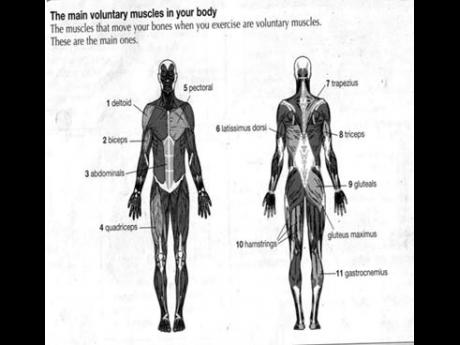The muscular system
Successful sporting action depends on our muscles working together to produce skillful movement. The muscles used depend on the activity or the phases of activity. Muscles work by shortening or contracting.
The muscles that move your bones when an activity is performed are the voluntary muscles. A voluntary muscle usually works across a joint. It is attached to both bones by tendons. The fibres of the tendons are embedded in the periosteum of the bone. This anchors the tendon and spreads the force of contraction. All muscles contract and develop tension. They work in pairs or groups because a muscle can only pull, it can't push. For example, the biceps and triceps work together.
To bend the arm, the biceps contract, the triceps relax. To straighten it, the triceps contract, the bicep relaxes. This is called antagonistic muscle action.
The other main pair that works together are the quadriceps and hamstrings. The muscle that contract or shortens is called the prime mover or agonist. The relaxing muscle is the antagonist.
There are other muscles called synergists that contracts at the same time as the agonist to help them work smoothly.
Origin and insertion
The origin of a muscle is where the muscle joins the stationary bone. The insertion is where it joins the moving bone. When a muscle contracts, the insertion moves towards the origin.
Muscle and their main actions
1. Deltoids (three muscles) - Raise your arm forward, backward, and sideways at the shoulder.
2. Biceps - Bend your arm at the elbow.
3. Abdominals (four muscles) - Pull in the abdomen. Flex the spine so you can bend forward.
4. Quadriceps (four muscles) - Straighten the leg at the knee. Keep it straight when you stand.
5. Pectorals (two muscles) - Raises your arm at the shoulder. Draw it across your chest.
6. Latissimus Dorsi (lats) - Pull your arm down at the shoulder. Draw it behind your back.
7. Trapezius - Holds and rotates your shoulders. Moves your head back and sideways.
8. Triceps - Straighten your arm at the elbow joint.
9. Gluteals (three muscles) - Pull your leg back at the hip. Raise it sideways at the hip. Gluteus maximus is the biggest of these muscles.
10. Hamstrings (three muscles) - Bend your leg at knee.
11. Gastrocnemius - Straightens the ankle joint so you can stand on your tip toes.
Types of muscle action
The type of resistance the muscle meet, determines the type of muscle action. There are two types of muscle action:
1. Concentric
2. Eccentric
Concentric muscle action
These are the most common type of contraction. The muscle actually shortens in length as it develops tension. There are two ways in which this happens.
n Isotonic action - the muscle shortens or contracts freely, eg. the biceps contract when curling a weight.
n Isometric action - the muscle shortens or contracts only a little before it is stopped from contracting further by an immovable resistance, e.g. trying to lift a weight you cannot move.
Eccentric muscle action
This occurs when the muscle is trying to contract while it is actually being lengthened by stretching, e.g. the quadriceps muscles at the front of the thigh when going downhill.
Types of muscles
There are three types of muscles in the body: voluntary, involuntary, and cardiac.
Voluntary muscles are attached to bones. They work when you want them to. Voluntary muscles are also called skeletal muscles or striped muscles.
Involuntary muscles are found in the walls of the internal organs - stomach, gut, bladder and blood vessels. They work on their own. Contractions in the walls of the blood vessels help to keep blood flowing.
Cardiac muscle is a special involuntary muscle that forms the wall of the heart. It works non-stop. Each contraction is a heartbeat.
Muscle fibres
Muscles are made up of cells called muscle fibre. There are two different types of fibres: slow twitch and fast twitch.
Slow-twitch fibres contract slowly, without much force, but do not tire easily and are suited for endurance activities.
Fast-twitch fibres contract much faster and with much more force, but tire quickly, They are suited to activities that need bursts of strength and power such as sprinting and weightlifting.
MUSCLE TONE
The state of partial contraction of muscles is called muscle tone. Groups of fibres take turns to contract so that muscles don't get too tired. Even when you are standing still, muscles are partly contracted. Muscle tone is important in maintaining the posture of the body and keeps the body ready for action.

